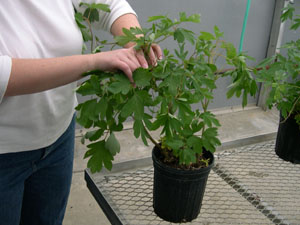Description

Sampling the youngest fully-expanded leaf. (photo courtesy of Marci Spaw)
Results
| Marconutrients (%) | Test Result | Acceptable Rangesz |
| N | 4.01 | 3.71-5.24 |
| P | 0.66 | 0.60-0.70 |
| K | 3.20 | 2.24-3.18 |
| Ca | 0.58 | 0.38-0.64 |
| Mg | 0.44 | 0.19-0.35 |
| S | 0.66 | 0.66-0.69 |
| Micronutrients (ppm) |
||
| Fe | 74 | 74-79 |
| Mn | 931 | 891-1504 |
| B | 20 | 20-24 |
| Cu | 6 | 4-6 |
| Zn | 103 | 87-101 |
| Mo | 0.89 | 0.66-1.08 |
| Nonessential Elements (ppm) |
||
| Na | 55 | 42-60 |
| Al | 64 | 23-210 |
zSurvey range for Dicentra eximia, fringed bleeding heart, reported in; Mills, H.A. and J.B. Jones. 1996. Plant Analysis Handbook II. MicroMacro Publishing, Inc., Atherns, GA.




